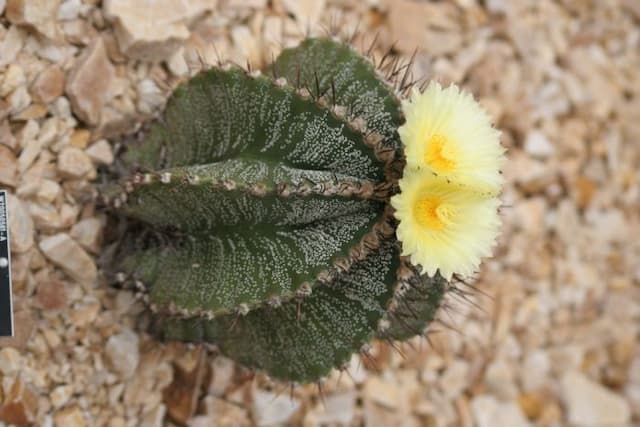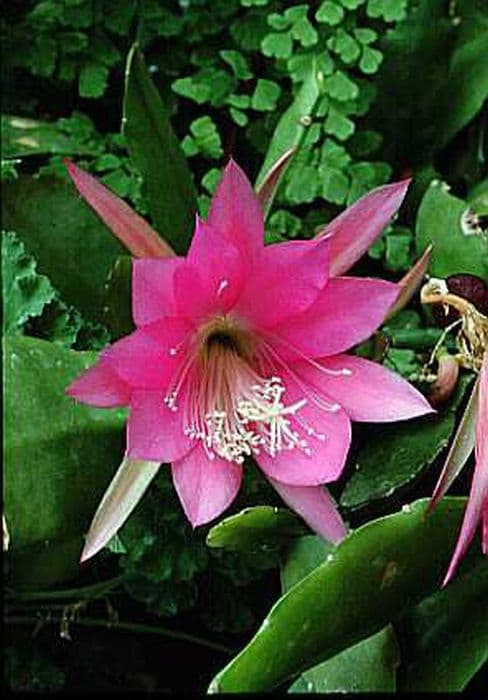Crown Cactus Rebutia steinbachii

ABOUT
Rebutia steinbachii, commonly known as the Crown Cactus, is a small, clustering cactus known for its vibrant, colorful flowers. The plant has a globular shape and typically grows in clusters, with multiple spherical stems emerging from the rootstock. The surface of these stems is divided into prominent ribs lined with small areoles from which emerge clusters of spines. The spines can range from white to yellowish in color and are quite fine and needle-like, often covering the stems densely enough to give them a somewhat bristly appearance. One of the most striking features of the Crown Cactus is its large, showy flowers that bloom in spring and early summer. The flowers are funnel-shaped and come in a variety of bright colors including red, orange, pink, and yellow. These blooms are significant in comparison to the body of the cactus and emerge near the crown at the top of the stems, hence the common name "Crown Cactus". The contrast between the flowers and the green to a bluish-green color of the stems creates a spectacular display. Despite its small size, Rebutia steinbachii can produce a generous quantity of flowers, sometimes covering the cactus in a colorful floral display. The plant's compact growth habit and the profusion of flowers make it a popular choice among cactus enthusiasts for rock gardens, windowsills, and as a part of small cactus collections.
About this plant
 Names
NamesFamily
Cactaceae.
Synonyms
Crown Cactus, Orange Crown Cactus, Hedgehog Cactus, Snowball Cactus.
Common names
Rebutia steinbachii subsp. steinbachii, Rebutia perplexa, Rebutia ritteri, Rebutia steinbachii var. gigantea, Rebutia steinbachii var. tiraquensis, Mediolobivia perplexa, Mediolobivia steinbachii.
 Toxicity
ToxicityTo humans
Rebutia steinbachii, commonly known as Crown Cactus, is not known to be poisonous to humans. There are no well-documented cases of toxicity from ingestion of this plant. However, as with many cacti, it's always wise to handle with care due to its spines and to avoid ingesting any part of the plant as a general safety precaution.
To pets
Crown Cactus is also not known to be toxic to pets. There is no significant evidence to suggest that pets would experience poisoning from ingesting parts of the Rebutia steinbachii. Nevertheless, it is advisable to prevent pets from chewing on cacti to avoid physical injury from the spines.
 Characteristics
CharacteristicsLife cycle
Perennials
Foliage type
Evergreen
Color of leaves
Varies
Flower color
Varies
Height
0 feet 2 inches (5 cm)
Spread
0 feet 6 inches (15 cm)
Plant type
Cactus
Hardiness zones
9
Native area
Bolivia
Benefits
 General Benefits
General Benefits- Decorative Appeal: Rebutia steinbachii, commonly known as Crown Cactus, is valued for its vibrant, colorful flowers that add aesthetic beauty to home and garden settings.
- Low Maintenance: Crown Cactus requires minimal care, making it an excellent choice for novice gardeners or those with limited time for plant maintenance.
- Drought Tolerance: Adapted to arid conditions, this cactus is highly drought-resistant, reducing the need for frequent watering and conserving water resources.
- Suitable for Small Spaces: With its compact size, Crown Cactus is an ideal plant for small indoor spaces, terrariums, or balconies where space is at a premium.
- Educational Interest: Cultivating Crown Cactus can provide an educational experience, offering learning opportunities about desert plants and ecosystems.
- Therapeutic Value: The act of caring for plants like the Crown Cactus can offer therapeutic benefits such as stress reduction and improved mood.
 Medical Properties
Medical PropertiesThis plant is not used for medical purposes.
 Air-purifying Qualities
Air-purifying QualitiesThis plant is not specifically known for air purifying qualities.
 Other Uses
Other Uses- The Crown Cactus can be used as a subject in macro photography to capture its detailed spines and colorful flowers, often used by amateur and professional photographers alike.
- In terrariums or miniature gardens, the Crown Cactus provides a visually appealing, low-maintenance addition that can tolerate the confined spaces.
- It's often gifted as a symbol of endurance and resilience, considering its ability to thrive in harsh environments, making it a thoughtful present for friends or family facing challenges.
- Crown Cactus can be employed in educational settings, such as schools or botanical workshops, to teach about plant adaptation and desert biomes.
- They are used in feng shui practices, placed in certain areas of the home or office to purportedly bring balance and positive energy, due to their spherical form which signifies unity.
- As a compact plant, it can be used in space-constrained urban environments to bring a touch of nature into small apartments or balconies.
- The Crown Cactus is used in xeriscaping, which is a landscaping method that reduces or eliminates the need for irrigation, making it suitable for drought-prone areas.
- Its colorful flowers can serve as a natural color guide for artists and designers seeking inspiration from organic and vibrant color palettes found in nature.
- This plant can also be included in children's educational kits about plant growth and care, offering a safe and non-toxic option for young, aspiring gardeners.
- The unique appearance of the Crown Cactus makes it a popular choice for collectors who specialize in rare and exotic plant species.
Interesting Facts
 Feng Shui
Feng ShuiThe Hedgehog Cactus is not used in Feng Shui practice.
 Zodiac Sign Compitability
Zodiac Sign CompitabilityThe Hedgehog Cactus is not used in astrology practice.
 Plant Symbolism
Plant Symbolism- Resilience: Rebutia steinbachii, commonly known as the Crown Cactus, is known for its resilience, as it can withstand tough conditions in its natural habitat.
- Beauty in Adversity: Despite originating from harsh environments, the Crown Cactus blooms with beautiful flowers suggesting a symbolic meaning of finding beauty despite challenging circumstances.
- Adaptation: This plant's ability to adapt to various growing conditions can symbolize the need to be flexible and adaptable in life's various situations.
- Thrive Under Pressure: Similar to other cacti, the Crown Cactus thrives in conditions where other plants might succumb, representing the ability to prosper under pressure.
 Water
WaterCrown cactus requires cautious watering to avoid root rot, especially during its dormant winter period. From spring to fall, water only when the soil is completely dry, roughly every 7 to 10 days, with about 8 ounces of water for a medium-sized pot. During winter, reduce watering to once a month, using just enough to prevent the soil from completely drying out.
 Light
LightThe crown cactus thrives in bright, indirect light, making an east- or west-facing window an ideal spot. Direct sunlight, especially in hot summer months, can scorch the plant, so a location with morning or late afternoon sun is best.
 Temperature
TemperatureCrown cactus prefers temperatures between 50°F and 75°F and can tolerate a minimum of 40°F. However, anything below freezing can be extremely harmful to the plant. For optimal growth, keep it in a location where temperatures are steady and avoid drafts.
 Pruning
PruningPruning is not typically necessary for the crown cactus as it maintains a compact form. However, if necessary, remove any dead or damaged parts using clean, sharp utensils to prevent infection. The best time for any pruning is at the onset of the growing season in spring.
 Cleaning
CleaningAs needed
 Soil
SoilThe Crown Cactus (Rebutia steinbachii) thrives in well-draining soil mix consisting of a combination of loam, sand, and perlite or pumice to enhance drainage. A slightly acidic to neutral soil pH of 6.0 to 7.5 is ideal for this cactus. Organic matter such as peat or coir can also be added to retain minimal moisture while preventing waterlogging.
 Repotting
RepottingThe Crown Cactus should typically be repotted every two to three years to refresh the soil and accommodate root growth. It is best to repot this plant during the warm growing season when the cactus is actively growing.
 Humidity & Misting
Humidity & MistingThe Crown Cactus prefers low to moderate humidity levels and does not require high humidity. It is well adapted to dry, arid environments and can be negatively affected by excessive humidity.
 Suitable locations
Suitable locationsIndoor
Place Crown Cactus in bright, indirect light indoors.
Outdoor
Grow Crown Cactus in sun to partial shade outdoors.
Hardiness zone
9-11 USDA
 Life cycle
Life cycleThe life cycle of Rebutia steinbachii, commonly known as Crown Cactus, begins with seed germination, a process that requires well-drained soil and consistent warmth, typically around 20°C (68°F), and can take anywhere from several weeks to months. Once germinated, the seedlings slowly develop into small, spherical cacti through a juvenile phase, characterized by the growth of spines and the initial formation of characteristic tubercles. As the cacti mature, they take on a clumping habit, producing offsets and forming clusters that contribute to their crown-like appearance. Throughout their adult life, Crown Cacti periodically bloom in the spring or early summer, displaying vivid, funnel-shaped flowers, usually in hues of orange, red, or pink, which are pollinated by insects to produce seeds. After pollination, fruits develop, containing new seeds for dispersal, thus continuing the plant's life cycle. The Crown Cactus has a long lifespan and can survive for many years with proper care, often outliving the individual flowers and fruits which are more ephemeral.
 Propogation
PropogationPropogation time
Spring-Early Summer
The optimal time to propagate Rebutia steinbachii, commonly known as Hedgehog Cactus, is during its active growth period in spring or early summer. The most popular method of propagation for this plant is by offsets. Hedgehog Cactus readily produces small offshoots that can be found at the base of the parent plant. These offsets can be gently removed once they are a respectable size, typically a couple of inches across, ensuring a portion of the root is attached. Once removed, it's important to let them dry for a few days to form a callus over the cut surface. This step helps to prevent rot when the offset is planted. To plant, one should use a well-draining cactus mix, and the offset should be placed on the surface, lightly pressing it into the soil. Water sparingly, just enough to moisten the soil without making it soggy, until roots have established, which can take a few weeks.









